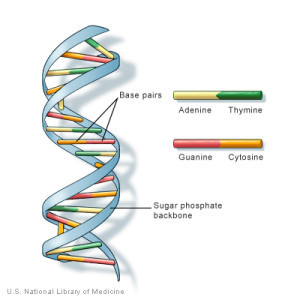Cooking with CRISPR

A strip of DNA
CRISPR sounds like some clever kitchen trick we should all know about. In fact, CRISPR is a radical new approach to medical and scientific research, one that adds a new level of urgency to a familiar question in bioethics.
Does the fact that we can do something [insert the medical or biological procedure of your choice] mean that we should do it?
Debate continues over the use of now-familiar medical technologies such as birth control, ventilators, and artificial nutrition. A whole different level of debate is associated with genetic engineering … things like stem cell research, cloning, or in vitro fertilization, as well as genetically modified organisms (GMOs) in the food supply.
Do we really know the full implications of genetic engineering on the future of the human race?
What Does CRISPR Do?
These debates take on an added urgency with the emergence of CRISPR (I will not burden you with the scientific name, which would take up nearly a full line of type)—a new tool for genetic engineering. CRISPR has been likened to the search function of a word processor. You decide what part of a gene you want to remove and/or replace, give CRISPR the appropriate instructions, and send it on its way. Voilá, the change is made.
Genetic work of the sort done by CRISPR has been around for nearly half a century … think of research into cystic fibrosis using mice or the development of pest-resistant corn. But before CRISPR, altering a gene was a laborious manual procedure. And once you had edited that gene, you had to breed and observe several generations of your subject (be it mice or corn) before you could tell if the experiment had worked as expected. Research on a single mutation could take as much as two years to determine success or failure.
According to a recent article in the New York Times, “altered genes frequently ended up in random locations, or in widely varying numbers” making it difficult to discern whether the concept was wrong … or whether it was a good idea that failed because of errors in the editing process. Progress was further slowed because you could only edit one gene one at a time; research on diseases thought to reflect the interaction of multiple genes (e.g., many forms of cancer) was halting at best.
 What makes CRISPR so significant is its speed, precision and breadth. Imagine a multi-pronged tool … a kind of biologic GPS that can accurately locate one or more genes in a segment of DNA … a pair of scissors to snip out the surrounding DNA … a tool to stitch up the DNA so it appears undisturbed. Because CRISPR can address multiple genes at the same time, projects that used to take months or years can now be done in a matter of days.
What makes CRISPR so significant is its speed, precision and breadth. Imagine a multi-pronged tool … a kind of biologic GPS that can accurately locate one or more genes in a segment of DNA … a pair of scissors to snip out the surrounding DNA … a tool to stitch up the DNA so it appears undisturbed. Because CRISPR can address multiple genes at the same time, projects that used to take months or years can now be done in a matter of days.
According to the New York Times, CRISPR is already being used to develop better biofuels and create new enzymes for things as diverse as laundry detergent and paper milling. Animal breeders produce superior lean-meat animals faster and more reliably than with crossbreeding. Dannon already deploys CRISPR to create strains of bacteria designed to produce more flavorful yogurt.
CRISPR’s Possibilities
Many scientists see great promise in CRISPR. It will facilitate targeted drug research … offer new insights into the role of genetics in mental illness … perhaps find a mechanism for eliminating mosquitos that carry Zika, dengue or Guillome-Barre.
It also offers the possibility of eliminating the BRCA gene for breast cancer … for ridding the world of Hodgkin’s lymphoma or AIDS. But scientists do not begin to understand the full significance of any specific genetic trait—or the consequences of changing it permanently. As a related article in the New Yorker notes the potentially devastating sickle cell anemia was an evolutionary protection against malaria. Would eliminating the gene for sickle cell lead to a dramatic increase in malarial deaths?
More broadly, what are the risks of modifying the genetic structure of embryos or “germ cells” that develop into eggs or sperm? Such changes would be passed on to all subsequent generations.
This concern has also been with us for nearly half a century. What is new is that genetic engineering projects that once required well-funded laboratories run by universities or corporations are now potentially available to almost anyone with a good head for science and access to decent laboratory facilities for relatively brief periods of time.
Does the fact that we can have CRISPR mean that we should use it?
P.S. A curious sidelight of this discussion is that one of the most prominent researchers in the CRISPR world is a 34-year-old scientist named Feng Zhang, who grew up in Des Moines, my home for the last 15 years.
The post Cooking with CRISPR appeared first on Mary Gottschalk - Author.



